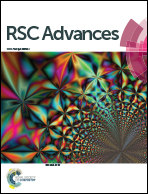Potentiometric multi-walled carbon nanotube Zn-sensor based on a naphthalocyanine neutral carrier: experimental and theoretical studies
Abstract
A new multi-walled carbon nanotube graphite paste sensor based on 2,11,20,29-tetra-tert-butyl-2,3-naphthalocyanine as a neutral carrier (2.0%), 2-flouorophenyl-2-nitrophenyl ether (50.0%) as a plasticizer, and sodium tetrakis-imidazolyl borate (1.0%) as an anionic additive has been explored as a selective sensor for determination of Zn2+ in real samples. The electrode showed a fast response time of 5 s, gave a Nernstian response (29.9 mV per decade) over the concentration range 1.0 × 10−8 to 1.5 × 10−4 mol L−1, and could be used in the pH range of 4.3–7.5 with a detection limit of 5.0 × 10−9 mol L−1. The response mechanism of the electrode was investigated using UV-vis and FT IR spectroscopy. Scanning electron microscopy combined with energy dispersive X-ray spectra were used to confirm the reaction between Zn2+ ions and naphthalocyanine on the surface of the electrode. In order to predict the selectivity of the naphthalocyanine sensor for different metal ions, the corresponding binding energies of the metal complexes were calculated at the Hartree–Fock level of theory.


 Please wait while we load your content...
Please wait while we load your content...